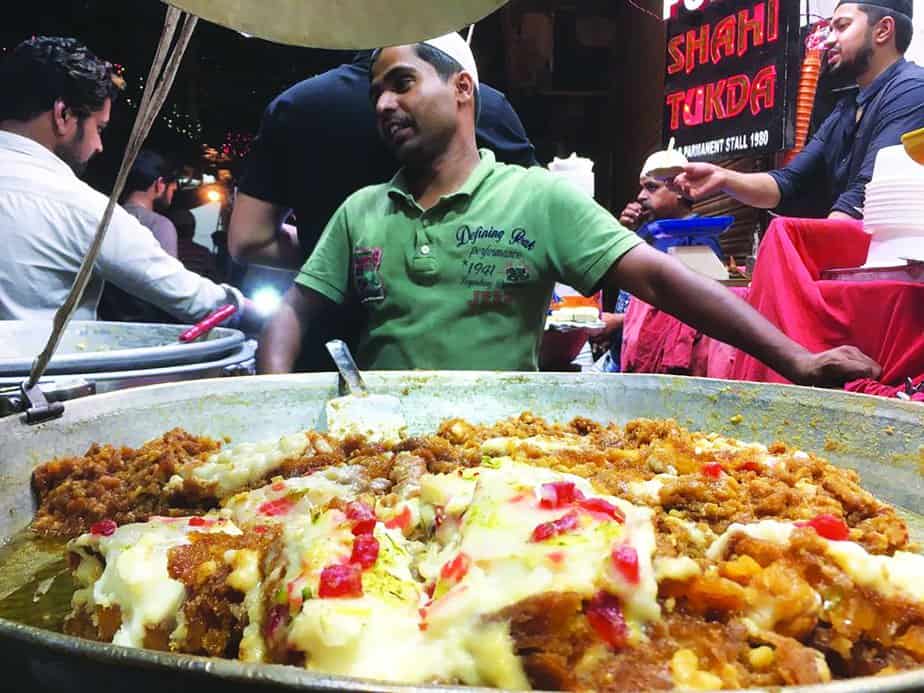
It is 2 am. The capital city has gone to sleep, the roads are empty and the silence of the night hovers over it. But, the lanes of Jama Masjid come alive during this hour with hundreds of people flocking in to satisfy their appetite.
This is the usual scene in New Delhi during the holy month of Ramzan, when Muslims observe a fast from sunrise to sunset.
Walking through the bustling lanes of Matia Mahal, the road opposite Jama Masjid, one cannot ignore the aroma of the searing hot, juicy kababs. From the tender mutton nihari, fried chicken, slow-cooked biriyani to heaps of breads and vermicelli — it’s a feast, no doubt about it. Both restaurants and street stalls offer a gastronomical delight to all the foodies of the city. The entire stretch is dotted with bright lights and colourful festoons adding to the festive street.
Crowded with men and boys clad in white caps and kurta-pajama, along with a sprinkling of women and girls, the roads near the mosque and Chandini Chowk area comes alive with the festive spirit. Pushing their way through the mad rush of people smiling faces, they struggle for a place to savour their favourite dishes.
The first stop is perhaps the most famous kebab joint in the area, the Qureshi Kabab Corner. This little joint is located right at the starting point of this famous kebab lane. Their main delicacy is soft mutton keema served hot right off the skewers. Costing a minimal Rs 45 a piece, these soft and long strands of mutton keema, served with melted butter and mint chutney, melt right in your mouth. “As the day of Eid approaches the crowd keeps increasing steadily,” explained Aslam Qureshi, owner of Qureshi Kebabs.
However, the must-try when you are in Jama Masjid is the chicken tikka served at various makeshift street stalls in the long stretch of the Matia Mahal lane. One of the more famous joints, Lalu Kababee serves the most famous tikkas. Mixed with spices, the pieces of chicken are put in skewers and roasted over a charcoal fire. These pieces of red chicken are put on your plate and served with mint chutney.
After the hearty meal of starters, indulge yourself with a round of the mouthwatering good main course. What better than the Eid special: haleem. Large chunks of buffalo meat cooked in dal, this is one of the most auspicious dishes served during Ramzan. Hotel Mustafa, a small joint located at one end of Matia Mahal lane, is the most famous outlet for this delicacy, as hundreds of people queue up in the middle of the night just to savour its taste. Served hot, fresh out of the pot it was cooked in, haleem is served with a tinge of ghee and some almonds sprinkled over it. A plate costs only Rs 50.
Not only does this lane offer a wide variety of meat delicacies, it is also known for its variety of rotis. The khameeri roti, a type of tandoori roti, the dough of which is made with milk instead of water, is a regular fare at all the joints. At Haji Shabrati Nihariwale, this roti, priced at Rs 10 per piece, is served with the legendary Nihari, a stew of large pieces of mutton dipped in a saucy gravy, that Mohd Akhlaq, owner of the restaurant, calls a Matia Mahal Road exclusive.
After this sumptuous meal, one longs for a good dessert, and the area provides a wide variety of dishes to satisfy one’s sweet tooth. The special dessert during the month of Ramzan is long strands of vermicelli, coated with sugar, dipped in milk. Popularly known as ‘dudh sewaiyan’ this dish is a favourite among the crowd, as lots of temporary stalls set up during this one month testify.
One can also savour the famous shahi tukda, a legendary Mughlai dessert, at Cool Point, a popular outlet. Priced at Rs 25 per plate, the shahi tukda, is an Indian cookie dipped in sugar syrup, and served with scoops of rabdi. The Cool Point is also famous for flavoured badaam milk and hot kheer.
Unlike other days of the year when the shops shut down by 1 am, the timing in the festive month changes. “During Ramzan all the stalls and shops here are open till 5 am, before people go to offer their morning prayers,” says Saqeeb Ali, while grilling kebabs at Lalu Kababee.
The festival also reflects the sense of generosity among people. Groups of poor people gather in front of the restaurants for a meal. From biriyani to bread, workers from the eateries distribute food every night during the month of the celebration. “We believe that by serving these people we are directly serving Allah,” says Jamal Khan, manager of Garib Nawaz.
The four cases are linked to the land-for-jobs and IRCTC scam, which are being probed…
This was followed by the Delhi Development Authority (DDA), which addressed 4,804 of the 5,197…
These local stores stock thicker jackets, practical sweaters, and everyday layers that are designed for…
Veer Ahlawat’s final-round 67 sealed a three-shot win at the Rs 1 crore CIDCO Open…
OnePlus has launched the 15R smartphone and Pad Go 2 tablet in India, with prices…
Nearly 2,800 Delhi vehicles denied fuel on first day of 'No PUC, No Fuel' drive…